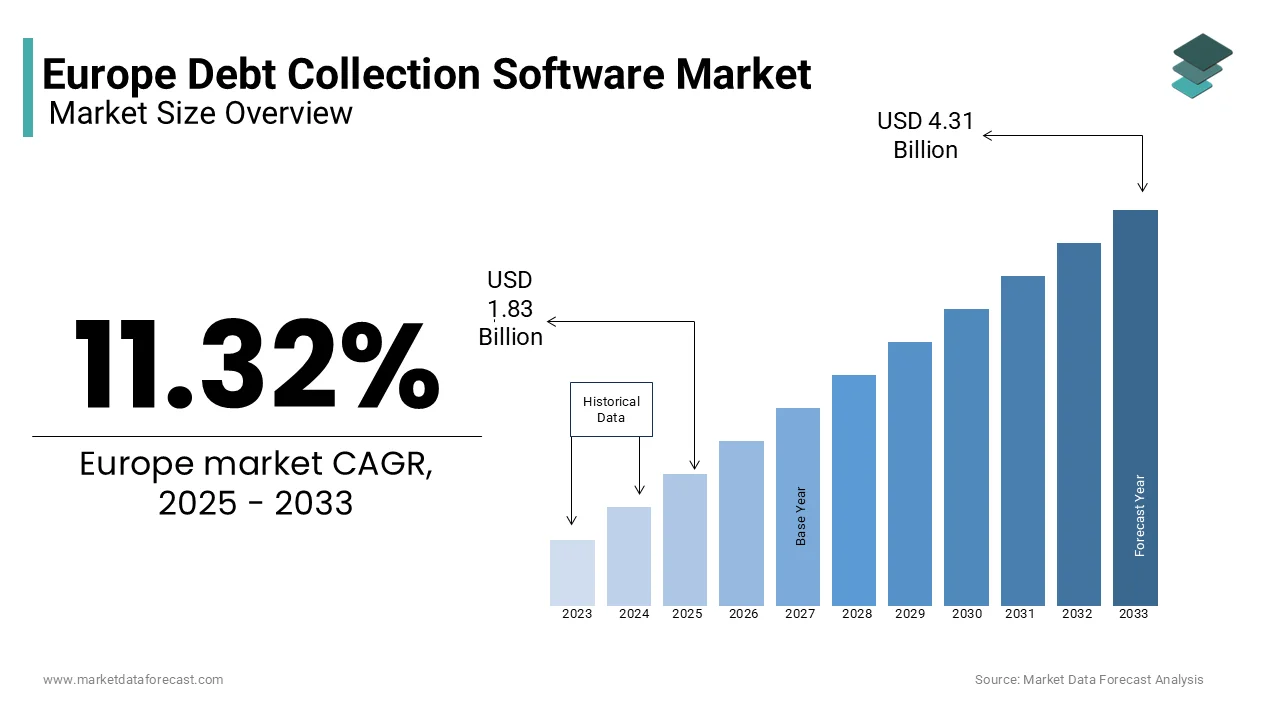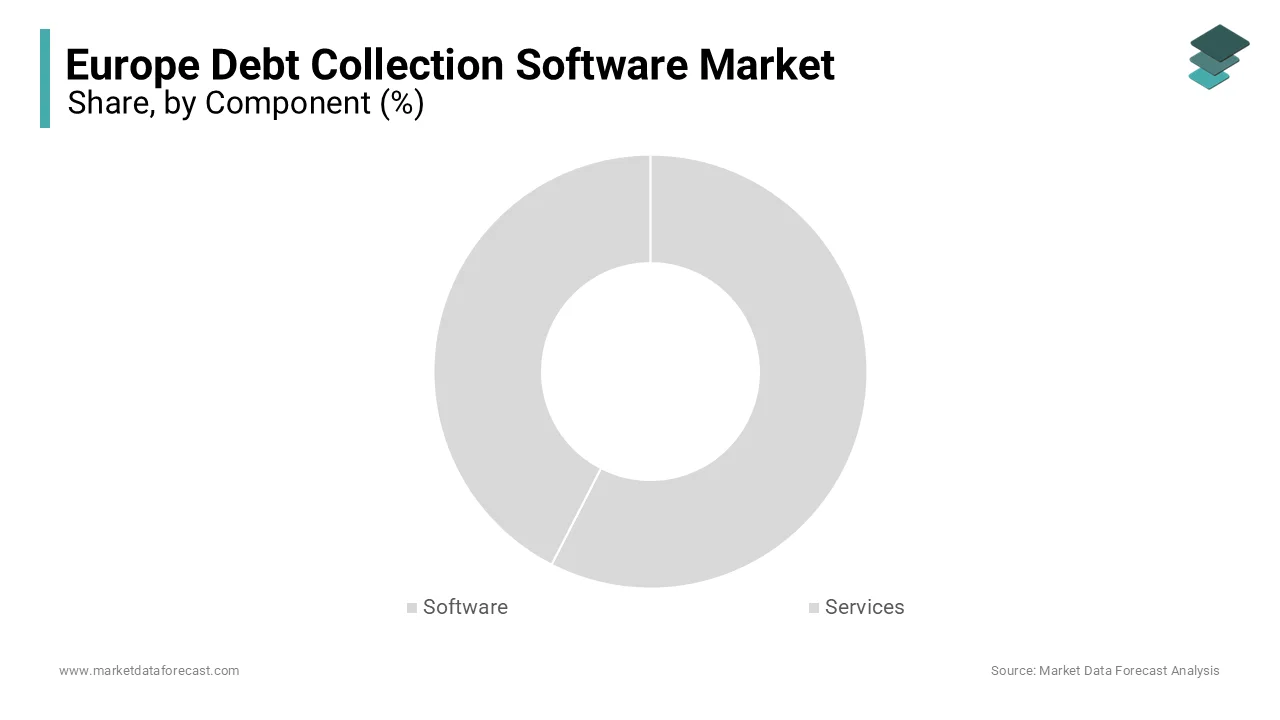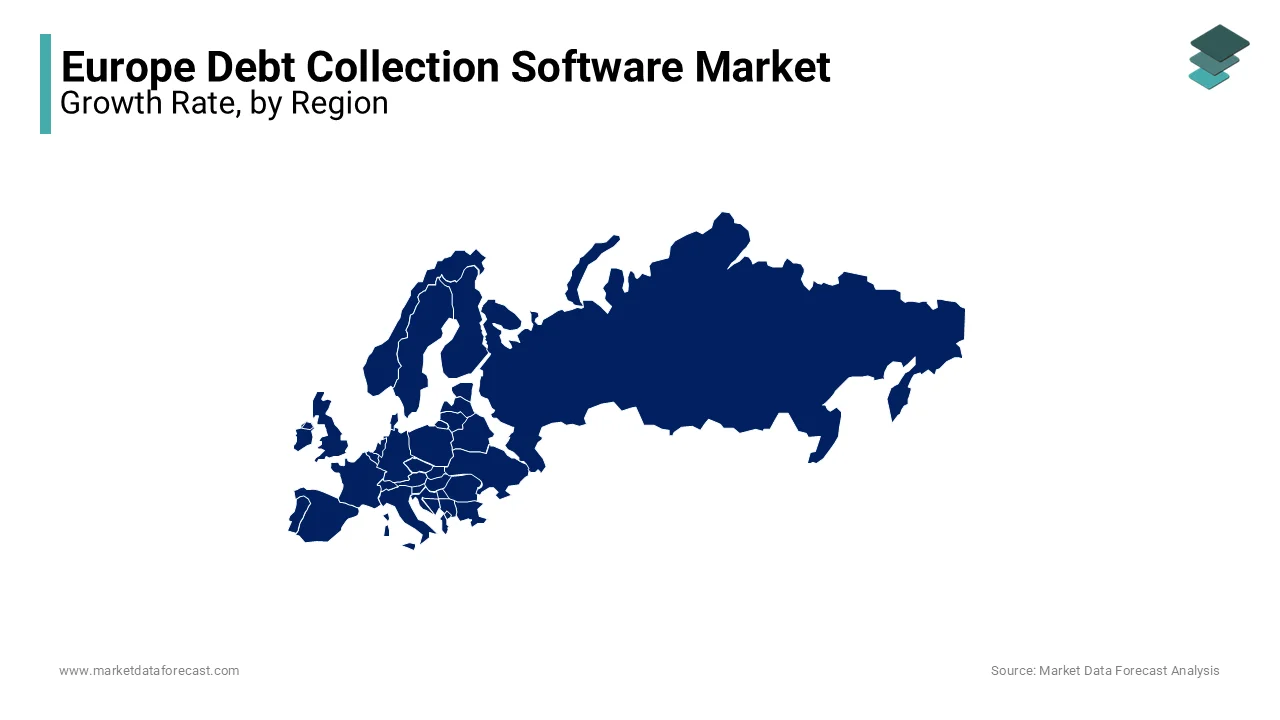Europe Debt Collection Software Market Size, Share, Trends, & Growth Forecast Report By Component (Software and Services), Deployment, Organization Size, End User, Country (UK, France, Spain, Germany, Italy, Russia, Sweden, Denmark, Switzerland, Netherlands, Turkey, Czech Republic & Rest of Europe), Industry Analysis From 2024 to 2033
Europe Debt Collection Software Market Size
The Europe debt collection software market was worth USD 1.64 billion in 2024. The European market is expected to reach USD 4.31 billion by 2033 from USD 1.83 billion in 2025, rising at a CAGR of 11.32% from 2025 to 2033.

The debt collection software is an advanced digital platform that automate and streamline the process of recovering overdue payments by enabling organizations to enhance operational efficiency, reduce costs, and ensure compliance with stringent regulatory frameworks such as the General Data Protection Regulation (GDPR). According to Eurostat, over 60% of European businesses reported challenges in managing late payments in 2022 the growing demand for innovative debt recovery tools. As per the European Central Bank, non-performing loans (NPLs) accounted for approximately 3.2% of total loans across the EU in 2022.
Countries like Germany, the UK, and France are leading adopters due to their robust financial sectors and high emphasis on regulatory adherence. According to the International Monetary Fund, the adoption of AI-driven debt collection software increased by 25% in 2022 by enabling predictive analytics and personalized communication strategies. According to the European Commission, automation has reduced manual intervention by 40% by improving accuracy and customer satisfaction.
MARKET DRIVERS
Increasing Adoption of Digital Solutions in Financial Services
The European financial sector is witnessing a significant shift towards digital transformation with the need for efficiency and compliance. According to Eurostat, over 68% of enterprises in the EU have adopted digital technologies to streamline operations, with debt collection being a critical area of focus. According to the European Central Bank, digital solutions reduce operational costs by up to 30% by making them an attractive option for financial institutions. This trend is further supported by the European Commission’s Digital Economy and Society Index with 72% of EU citizens use internet banking services. The demand for debt collection software rises by enabling better data management and customer interaction.
Stringent Regulatory Frameworks Governing Debt Recovery
Europe's stringent regulatory environment significantly influences the adoption of debt collection software. According to the European Data Protection Supervisor, GDPR compliance is mandatory and impacting how personal data is managed during debt recovery processes. Non-compliance can result in fines up to €20 million or 4% of annual global turnover, as per the European Commission. Additionally, the European Banking Authority mandates transparent and fair debt collection practices by pushing institutions to adopt compliant software solutions. As per the Organisation for Economic Co-operation and Development, standardized regulations increase software adoption rates by ensuring adherence to legal standards. These frameworks necessitate advanced software capabilities is driving market growth as institutions seek reliable tools to navigate complex regulatory landscapes.
MARKET RESTRAINTS
High Initial Implementation Costs and Resource Constraints
The adoption of debt collection software in Europe is often hindered by the high upfront costs associated with implementation. According to the European Investment Bank, small and medium-sized enterprises (SMEs), which form a significant portion of the market, face budgetary constraints, with over 40% citing financial limitations as a barrier to digital transformation. As per the Eurostat, nearly 35% of SMEs struggle to allocate sufficient resources for training staff to effectively use such software. These costs include not only the software purchase but also integration with existing systems, cybersecurity measures, and ongoing maintenance. For many businesses, especially smaller ones, these expenses outweigh the perceived immediate benefits. This financial burden creates hesitation by slowing down the broader adoption of debt collection software across Europe.
Privacy Concerns and Consumer Resistance to Automated Systems
The privacy concerns and consumer resistance pose significant challenges to the growth of the debt collection software market in Europe. According to the European Data Protection Supervisor, 67% of consumers express discomfort with automated systems handling sensitive financial data due to fears of misuse or breaches. A survey conducted by the European Consumer Organisation studies revealed that over 50% of individuals prefer human interaction during debt recovery processes by perceiving it as more empathetic and trustworthy. These attitudes are compounded by frequent media reports of data breaches, which further erode trust in digital solutions. Companies face difficulties in convincing both consumers and regulatory bodies of the reliability and security of automated systems by creating a restraint on market expansion.
MARKET OPPORTUNITIES
Growing Demand for AI-Driven Predictive Analytics in Debt Recovery
The integration of artificial intelligence (AI) and predictive analytics presents a significant opportunity for the European debt collection software market. The European Commission’s Digital Transformation Monitor, AI adoption in financial services is projected to grow by 25% annually, with predictive analytics enabling more accurate debtor behavior assessments. According to Eurostat, over 60% of financial institutions are investing in AI tools to enhance decision-making processes, as these technologies can reduce recovery times by up to 40%. According to the European Central Bank, the AI-driven insights can improve recovery rates by identifying high-priority accounts. This technological advancement not only enhances efficiency but also aligns with the increasing demand for data-driven solutions by positioning debt collection software as a critical tool for modern financial operations.
Expansion of Cross-Border Debt Collection Services Across Europe
The harmonization of regulations within the European Union creates a fertile ground for cross-border debt collection services by offering substantial growth opportunities. The European Commission intra-EU trade exceeded €3.8 trillion in 2022 with the scale of cross-border transactions and the associated debt recovery needs. According to the European Banking Authority, standardized frameworks like the European Payment Order facilitate smoother debt recovery across member states by encouraging software providers to develop multi-jurisdictional solutions. A study by the Organisation for Economic Co-operation and Development reveals that businesses lose approximately €140 billion annually due to unpaid cross-border invoices. Debt collection software can tap into a growing market by offering scalable and compliant solutions to meet the demands of an interconnected European economy.
MARKET CHALLENGES
Growing Demand for AI-Driven Predictive Analytics in Debt Recovery
The integration of artificial intelligence (AI) and predictive analytics presents a significant opportunity for the European debt collection software market. According to the European Commission’s Digital Transformation Monitor, AI adoption in financial services is projected to grow by 25% annually with predictive analytics enabling more accurate debtor behavior assessments. According to Eurostat, over 60% of financial institutions are investing in AI tools to enhance decision-making processes, as these technologies can reduce recovery times by up to 40%. A study by European Central Bank reveals that leveraging AI-driven insights can improve recovery rates by identifying high-priority accounts. This technological advancement not only enhances efficiency but also aligns with the increasing demand for data-driven solutions by positioning debt collection software as a critical tool for modern financial operations.
Expansion of Cross-Border Debt Collection Services Across Europe
The harmonization of regulations within the European Union creates a fertile ground for cross-border debt collection services by offering substantial growth opportunities. According to the European Commission, intra-EU trade exceeded €3.8 trillion in 2022 with the scale of cross-border transactions and the associated debt recovery needs. Standardized frameworks like the European Payment Order facilitate smoother debt recovery across member states by encouraging software providers to develop multi-jurisdictional solutions. A study by the Organisation for Economic Co-operation and Development reveals that businesses lose approximately €140 billion annually due to unpaid cross-border invoices. Debt collection software can tap into a growing market by offering scalable and compliant solutions to meet the demands of an interconnected European economy.
REPORT COVERAGE
|
REPORT METRIC |
DETAILS |
|
Market Size Available |
2024 to 2033 |
|
Base Year |
2024 |
|
Forecast Period |
2025 to 2033 |
|
CAGR |
11.32% |
|
Segments Covered |
By Component, Deployment, Organization Size, End User, and Country |
|
Various Analyses Covered |
Regional & Country Level Analysis, Segment-Level Analysis, DROC, PESTLE Analysis, Porter’s Five Forces Analysis, Competitive Landscape, Analyst Overview on Investment Opportunities |
|
Countries Covered |
UK, France, Spain, Germany, Italy, Russia, Sweden, Denmark, Switzerland, Netherlands, Turkey, Czech Republic, and Rest of Europe |
|
Market Leaders Profiled |
Chetu Inc., Codix, Experian Information Solutions, Inc., Fair Isaac Corporation, Ferber-Software GmbH, Nucleus Software Exports Ltd., Pegasystems Inc., Temenos Headquarters SA, TietoEVRY, and TransUnion LLC. |
SEGMENTAL ANALYSIS
By Component Insights
The software segment dominated the market by occupying 65.1% of the Europe debt collection software market share in 2024 due to the increasing adoption of advanced software solutions for automating debt recovery processes, reducing human error, and ensuring compliance with stringent regulations like GDPR. According to the European Central Bank, institutions leveraging software solutions achieve a 30% improvement in operational efficiency. The software segment remains critical in streamlining workflows and enhancing data accuracy with over 70% of financial institutions prioritizing digital tools. Its importance lies in enabling scalable, real-time debtor tracking and analytics by making it indispensable for modern debt collection operations.

The services segment is ascribed in holding the Europe Debt Collection Software Market with a CAGR of 14.2% during the forecast period. This rapid growth is driven by the rising demand for customization, training, and post-implementation support, as per the European Commission’s Digital Economy Report. Over 50% of businesses require tailored services to integrate software with legacy systems, while 45% seek ongoing technical assistance. The Organisation for Economic Co-operation and Development notes that service-driven models enhance customer satisfaction by addressing specific client needs. The need for advisory and compliance-related services further accelerates this segment's growth by making it vital for sustained market expansion.
By Deployment Insights
The cloud deployment segment led the market and held 60.1% of Europe debt collection software market share in 2024 which is driven by the demand for cost-effective, scalable, and flexible solutions. According to the European Commission, over 40% of enterprises have adopted cloud services, with debt collection software benefiting from real-time data access and enhanced security compliance, such as GDPR. Cloud solutions reduce IT infrastructure costs by up to 30%, according to the European Investment Bank by making them ideal for SMEs. This segment's importance lies in enabling digital transformation by ensuring remote accessibility, and supporting efficient debt recovery processes, which are critical in today’s dynamic business environment.
The cloud deployment segment is anticipated to witness a fastest CAGR of 17.8% from 2025 to 2033 due to increasing investments in digitalization and the need for secure, compliant solutions. According to the Eurostat, the cloud adoption among European businesses is projected to grow by 25% annually which is driven by its ability to integrate AI and analytics for improved recovery rates. According to the European Data Protection Supervisor, cloud solutions simplify GDPR compliance through automated data management. The cloud deployment is becoming indispensable by offering transformative opportunities for the debt collection software market while addressing evolving regulatory and operational demands.
By Organization Size Insights
The small & medium Enterprises (SMEs) segment dominated the Europe debt collection software market with a 55.1% of share in 2024. The high prevalence of SMEs in Europe, which account for over 99% of all businesses is greatly influencing the growth rate of the market. SMEs face significant cash flow challenges, with 40% struggling to recover debts manually is driving their adoption of cost-effective and scalable solutions. Cloud-based software has made these tools accessible by reducing upfront costs by up to 30%, per the European Investment Bank. Their adoption of debt collection software is vital for improving financial stability and operational efficiency as SMEs form the backbone of Europe’s economy.
The large enterprises segment is likely to register a fastest CAGR of 14.2% from 2025 to 2033. This growth is fueled by the need for advanced analytics, AI-driven insights, and integration with legacy systems to manage high debt volumes efficiently. According to the Eurostat, large enterprises handle over 60% of Europe’s debt recovery operations by making automation critical. As per the European Commission, these organizations report a 25% improvement in recovery rates using advanced tools. The rapid adoption of innovative solutions elevates the growth of the segment in the coming years.
By End User Insights
The institutions, such as banks and financial organizations, dominated the Europe debt collection software market with 55.6% share in 2024. The responsibility for managing high volumes of non-performing loans (NPLs) was accounted for 2.3% of total loans in the Eurozone in 2022, as per the European Central Bank. Institutions prioritize automated solutions to reduce recovery costs and ensure compliance with regulations like GDPR. According to the European Banking Authority, institutions using advanced software achieve up to a 30% improvement in recovery rates. As key pillars of Europe’s financial system, institutions’ adoption of these tools is critical for maintaining stability and operational efficiency.
The collection agencies segment is attributed to acheive significant CAGR of 16.8% during the forecast period. This growth is fueled by the rising trend of outsourcing debt recovery tasks, with Eurostat over 40% of such tasks are now managed by agencies. These agencies leverage software for real-time debtor communication, payment tracking, and compliance management by reducing operational costs by 25%, according to the European Commission. The demand for specialized tools enabling efficient and compliant operations has surged as businesses seek cost-effective recovery methods.
REGIONAL ANALYSIS
The United Kingdom was accounted in holding 25.2% of Europe debt collection software market. The advanced digital infrastructure and high adoption rates of cloud-based solutions, which streamline debt recovery processes. According to the UK Office for National Statistics, over 70% of UK businesses have embraced digital tools to enhance operational efficiency. Additionally, stringent data protection laws like GDPR have pushed organizations to adopt compliant software solutions. The UK’s focus on innovation and automation is leveraging the growth rate of the market. The country’s robust financial sector and proactive government policies further boosts the market growth rate.

Germany is projected to experience a CAGR of 15.3% during the forecast period. The country’s strong financial sector and emphasis on regulatory compliance have fueled the adoption of debt collection software. According to the German Federal Ministry for Economic Affairs, German banks and financial institutions prioritize secure and efficient recovery systems by driving demand for advanced tools. Germany benefits from its technological prowess and integration of AI-driven analytics. The rising focus on digital transformation and increasing per capita income are prompting the growth rate of the market. Germany’s focus on scalability and data security further enhances its prominence in the regional market.
France is likely to have a prominent growth opportunity in the next coming years. The country’s focus on AI-driven tools and automation has positioned it as a fast-growing market for debt collection software. According to the French National Institute of Statistics, French enterprises adopting AI-powered solutions achieve up to a 30% improvement in recovery rates. France’s emphasis on innovation and efficiency is attributed in leveraging the growth rate of the market. Government initiatives are promoting digitalization and financial stability will further support this trend. France’s strategic investments in cutting-edge technologies and its alignment with GDPR compliance enhances its importance in shaping the future of the debt collection software market across Europe.
KEY MARKET PLAYERS
The major players in the Europe debt collection software market include Chetu Inc., Codix, Experian Information Solutions, Inc., Fair Isaac Corporation, Ferber-Software GmbH, Nucleus Software Exports Ltd., Pegasystems Inc., Temenos Headquarters SA, TietoEVRY, and TransUnion LLC.
MARKET SEGMENTATION
This research report on the Europe debt collection software market is segmented and sub-segmented into the following categories.
By Component
- Software
- Services
By Deployment
- Cloud
- On-premise
By Organization Size
- Small & Medium Enterprises
- Large Enterprises
By End User
- Institutions
- Collection Agencies
- Others
By Country
- UK
- France
- Spain
- Germany
- Italy
- Russia
- Sweden
- Denmark
- Switzerland
- Netherlands
- Turkey
- Czech Republic
- Rest of Europe
Frequently Asked Questions
What is driving the growth of the Europe debt collection software market?
The market is growing due to the rising demand for automation in debt recovery processes, increasing digitalization of financial services, and regulatory compliance requirements across European countries.
Which industries are the primary users of debt collection software in Europe?
Financial institutions, healthcare, government agencies, telecom, and utility service providers are the main users of debt collection software due to high volumes of outstanding payments.
What role does artificial intelligence play in European debt collection software?
AI enhances debt recovery efficiency by predicting debtor behavior, optimizing collection strategies, and automating communication based on payment patterns.
What is the future outlook for the Europe debt collection software market?
The market is expected to continue growing with advancements in AI, increased adoption of cloud-based solutions, and a stronger focus on regulatory compliance.
Related Reports
Access the study in MULTIPLE FORMATS
Purchase options starting from $ 2000
Didn’t find what you’re looking for?
TALK TO OUR ANALYST TEAM
Need something within your budget?
NO WORRIES! WE GOT YOU COVERED!
Call us on: +1 888 702 9696 (U.S Toll Free)
Write to us: [email protected]